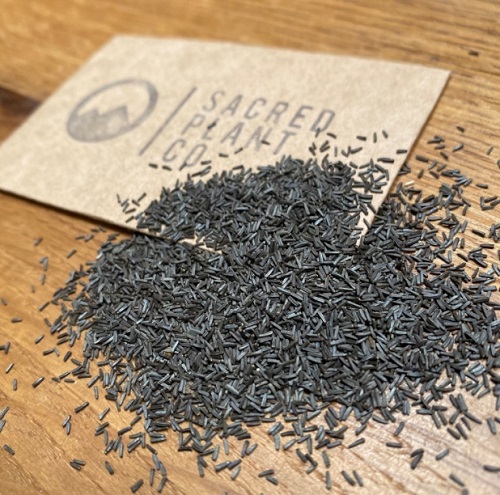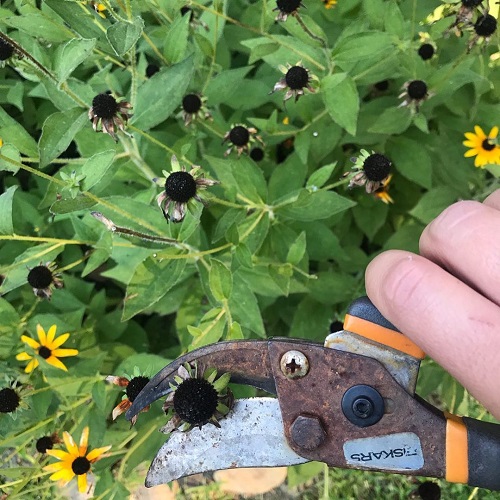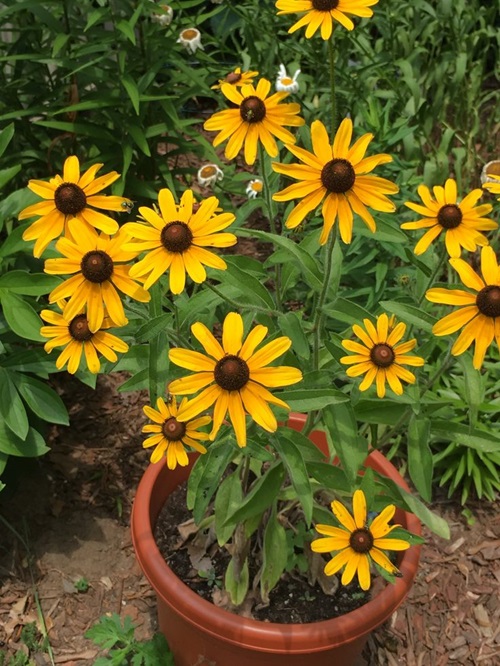Wondering What to Do With Black-Eyed Susans After They Flower? We have a few tricks to help you make the most of these beautiful plants.

With winter comes the end of the season for several blooms, including the sunny, daisy-like Rudbeckia hirta. So what do you do with black-eyed Susans after they flower? Thankfully, these cheery ornamentals are pretty forgiving to neglect, but a few tricks help. Let’s dig in!
What to Do With Black-Eyed Susans After They Flower
1. Allow Them to Overwinter
Overwintering black-eyed Susans is a sophisticated way of saying, “Just be a lazy gardener and let them die back” during winter. With seedheads still intact, songbirds, butterflies, small mammals, and several pollinators will flock to them for food and sustenance.
This tall perennial doesn’t require heavy fertilization, but in the fall, add an inch or two of compost and mulch just around the base and then let it overwinter. This helps retain moisture, improve soil fertility, and insulate the plant during harsh winters.
Note: Keep mulch a few inches away from the plant’s crown to avoid rot.
2. Collect the Seeds
Thriving in USDA zone 3-9, this plant can grow as a short-lived perennial or biennial, depending on the region and climate. Save the seeds once your black-eyed Susan has finished flowering, and start them indoors about 7-10 weeks before the last expected frost date.
When storing seeds, ensure the paper bags or envelopes are breathable to prevent mold, and put them away in a cool, dry spot. Remember to clean the seeds and remove any unwanted residue that can cause disease.
3. Divide and Transplant
If you’re too lazy to collect and store seeds, you could just divide and transplant after the plant’s flowering cycle. Carefully dig out an existing Rudbeckia without damaging the roots, shake off the soil, split it into smaller plants, and replant in the barren bits of the garden.
Divide and transplant your perennials mid-to-late fall as they enter dormancy. This will ensure that your transplants grow healthy in their new home. When dividing cultivars grown in pots, follow most of the steps above.
When you reach the roots, use a sharp knife to split the root ball into smaller sections. Then, divide the divisions into fresh or thoroughly washed containers with a well-draining potting mix.
4. Deadhead Your Rudbeckias

Unless you want seeds after your black-eyed Susans bloom, don’t hesitate to deadhead spent flowers. Deadheading helps your plant conserve energy, especially as it prepares for winter hibernation.
When the flowers begin to fade, your plant will continue to waste energy on them. Deadheading cuts that wasted energy and play a vital role in securing robust blooms in the following season.
5. Prune Your Black-Eyed Susans
If you live in slightly warmer regions, USDA zones 6-9, prune your Rudbeckias so that only 4-6 inches of growth above ground remains. Do this in mid to late fall or 6-8 weeks before your region’s first expected frost date.
Don’t cut too close to the ground, or else it will damage the crown and your plant. With old, wilted stems and flowers gone, pests won’t have room to inhabit the dead, rotting bits of the plant.
Now, if you’re growing your Black-Eyed Susans in colder regions, USDA Zones 3-5, we recommend waiting until the first frost to prune your plants. After that, cut back until only 12 inches of stems are left. Longer stems will help trap the snow and insulate the crown.
In cold-prone areas, you can even leave your Rudbeckias unpruned and do it later in early spring after all dangers of frost are passed. As shared in the first point, leaving the seedheads intact will also help birds and insects in winter.
6. Tips for Potted Black-Eyed Susans After Flowering

Apart from deadheading and pruning like above, if your plant has outgrown its pot and you live in a warmer area like Zone 8 and above, early fall is a good time to divide and repot.
It is crucial to keep the pots sheltered from extreme weather and harsh, dry winds during winter. Choose a sunny patio, a south-facing wall sheltered from cold drafts, or a window with sufficient sunlight.
In addition to all these measures, you’ll also need to wrap the outdoor pots with burlap or bubble wrap to protect the roots from the freezing ground.
This native wildflower thrives in well-draining, moist mediums but can tolerate occasional dry soil and is quite drought-tolerant once mature. Avoid planting it in sections of the garden that are rich in nitrogen, such as lawn edges, as this will hamper its blooms.


